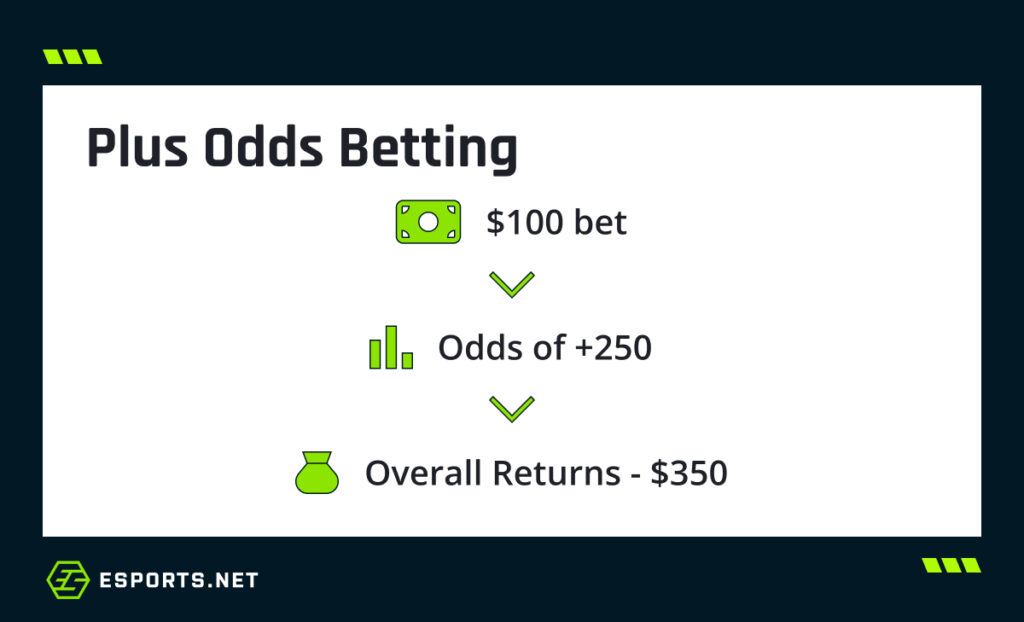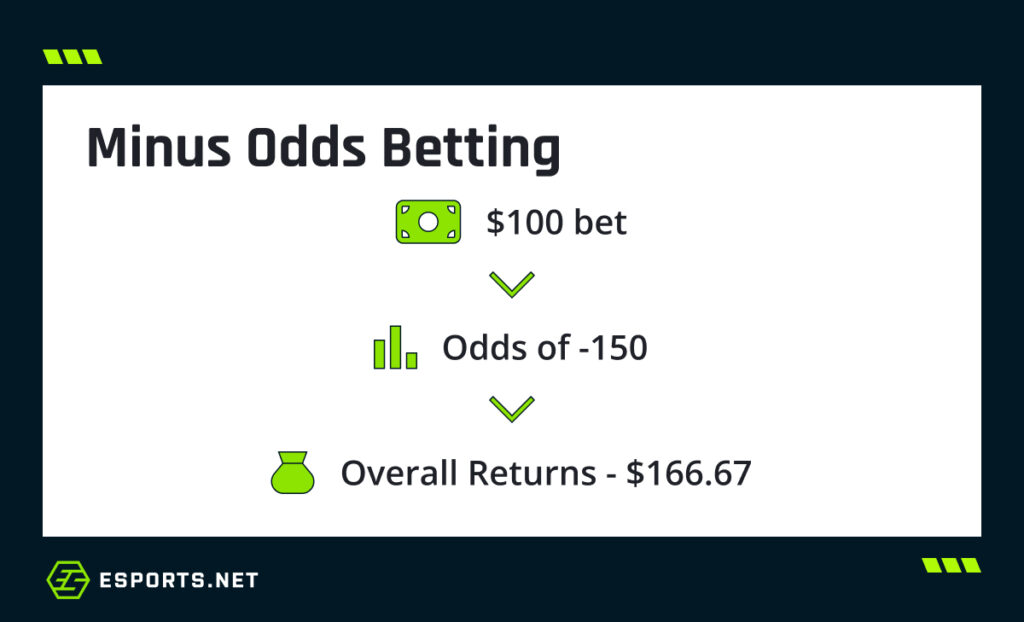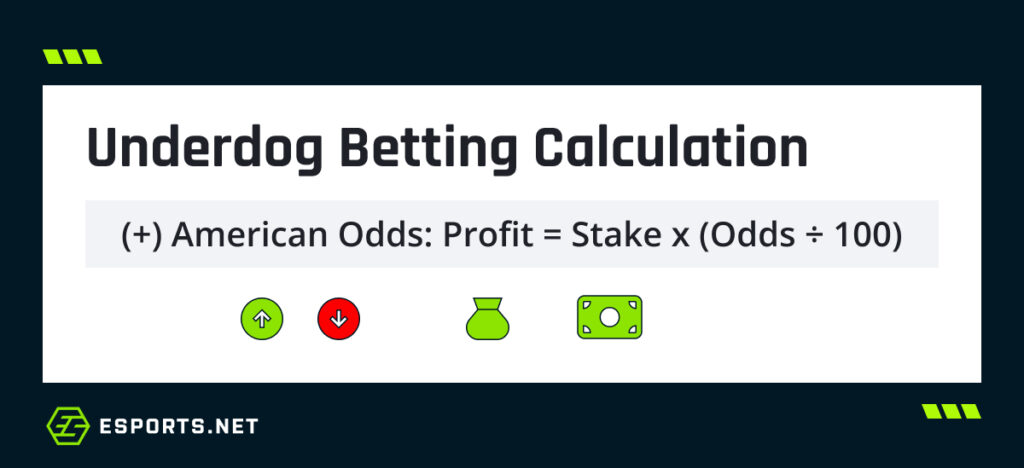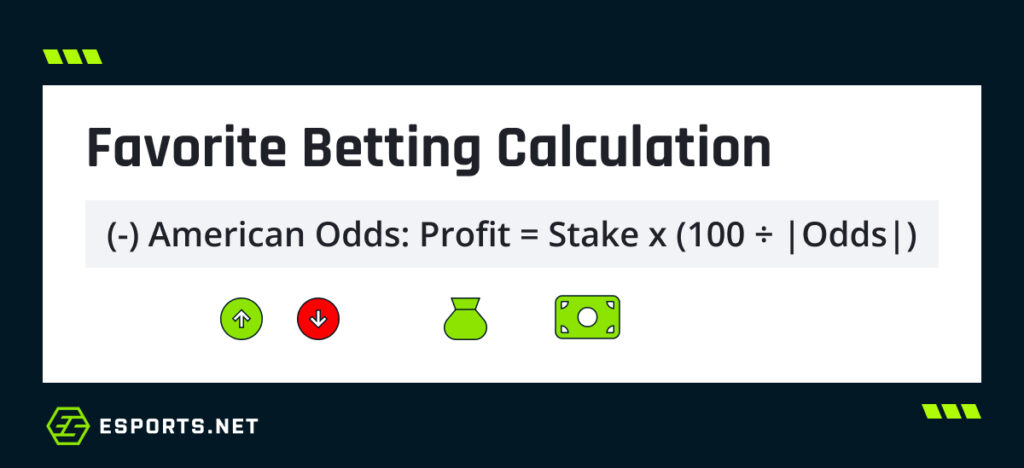What Does Plus & Minus Mean In Esports Betting?
- In esports betting, the plus and minus symbols are displayed next to the odds in the American odds system.
- The minus (-) sign reflects the favorite in a matchup, while the plus (+) sign indicates the underdog.
- The minus symbol shows you how much you need to wager to win $100. The plus symbol shows you how much you would win if you bet $100.
If you’ve ever wondered what + and − mean in esports betting, these symbols represent the American odds format. They’re key to understanding how betting lines work by showing who’s favored to win and how much you stand to gain (or risk) in a wager.
In this guide, we explain the esports betting plus minus meaning, how they affect payouts, how to calculate returns using simple formulas, and which is preferred in terms of value for you as the bettor.

- 1. What Do + And – Mean In Esports Betting?
- Plus Odds Betting Example
- Minus Odds Betting Example
- 2. How To Calculate Returns From Plus & Minus Odds In Betting
- Underdog Betting Example
- Favorite Betting Example
- 3. Which Provides Bettors With More Value?
- How To Decide If A Bet Is Worth It
- 4. Negative vs. Positive Betting Odds
- 5. FAQs
- 6. References
What Do + And – Mean In Esports Betting?
Plus (+) and minus (-) odds are part of the American odds system and highlight who is the underdog or favorite in a matchup. The minus sign (-) represents the favorite and indicates how much you must stake to win $100. The plus sign (+) marks the underdog and shows the profit you’d make from a $100 bet.
Understanding these symbols is crucial in esports betting because they instantly help you gauge risk versus reward. A bet placed on a favorite typically yields lower returns, but at a higher probability of winning. In contrast, backing an underdog offers bigger payouts but at greater risk.
American odds formats can be a bit confusing, especially if you’re used to European sportsbooks that primarily use decimal odds (e.g., 1.80). This is because the numbers technically don’t mean the same thing. But don’t worry, you’ll quickly get the hang of it after a few bets.
Let’s look at a few examples to see how plus and minus odds work in esports betting and what they mean in real matchups.
Plus Odds Betting Example
Let’s say you bet $100 on Xtreme Gaming at The International. The line is listed at +250 for them to win a Group Stage match. The +250 means that for every $100 you wager, you’d win $250 if they pull off the upset. Because they have the plus symbol next to their odds, they’re the underdogs.
This means that your total payout for this bet would be $350 (your initial $100 stake plus $250 profit). In esports betting, upsets from underdogs tend to happen frequently. And since backing the underdog can lead to big returns, it’s a popular bet choice among many bettors.

Minus Odds Betting Example
Imagine you bet $100 on Team Vitality at ESL Pro League Season 22. They are the favorites to win their CS2 match and are priced at -150. In this example, the -150 means you need to risk $150 to win $100. Since you’re only staking $100, your profit would be $66.67 if Vitality wins their match.

This means your total payout would be $166.67 (your initial $100 stake plus the $66.67 profit). As you can see, betting on a favorite offers significantly lower returns than betting on an underdog—but they have a higher chance of winning.
With that, you should have a solid grasp of how plus and minus odds work in esports betting.
How To Calculate Returns From Plus & Minus Odds In Betting
If you’re still new to esports betting, it’ll be good to understand how your payouts are calculated from plus and minus odds. In this section, we explain an example of each and take a closer look at the calculations behind the bets.
The odds attached to a bet determine the profit you’ll make if your bet wins and how much you need to risk. However, keep in mind what we discussed earlier: plus odds show you how much profit you’ll make from a $100 bet, while minus odds show you how much you must stake to win $100.
Underdog Betting Example
Suppose you’re betting on an underdog team at VALORANT Champions Paris with odds of +200. This means if you wager $100 and your predicted team wins, you’ll net $200 in profit. In that case, your total payout would be $300 ($100 stake plus the $200 profit). Easy, right?
But let’s take a smaller amount like $50. If you’re not betting $100, you need to calculate it proportionally as: $50 x (200 ÷ 100) = $100 profit. To do this for other amounts, you can use the following formula:

It might not be intuitive, but the higher the positive number is in American odds, the less likely the bookmaker thinks the team will win. However, the trade-off is that higher odds also mean a bigger potential payout if the team pulls off the win.
Odds are based on a sportsbook’s analysis of an outcome, factoring in team or player performance, roster changes, tournament formats, and more. They can also change over time. For example, a team’s odds could drop as low as +1250 if they’re losing badly in a match.
Favorite Betting Example
For the next example, let’s consider a more conservative bet. Imagine Gen.G is competing against FlyQuest at the League of Legends World Championship. Gen.G is the clear favorite to win the match with odds priced at -150. This means you need to stake $150 to make $100 profit.
Again, the return is straightforward if you’re betting $150. But suppose you only want to bet $75. In that case, you’ll need to do a bit of math to work out your potential profit: $75 x (100 ÷ 150) = $50 profit. To do this for other amounts, you can calculate it as:

The formula is similar to the one used to work out profits for (+) American odds, except the elements inside the bracket are reversed compared to an underdog bet. In this case, the more negative a number is (e.g., -200 versus -150), the lower the payout.
This is because negative American odds represent the favorites in a matchup, meaning that the bookmaker expects them to win based on their research. However, since the risk is lower, the payout is comparatively smaller compared to betting on an underdog.
Which Provides Bettors With More Value?
The value for bettors often lies with plus odds. These bets represent the underdogs and offer higher potential payouts for a smaller stake. The catch is that the team has a lower chance of winning (hence being the underdogs). For example, a +150 wager on a $100 bet would return $150 in profit if the team wins.
On the other hand, the minus bets represent the favorites. Here, you’re risking more money for a smaller payout if the team wins. That’s because they have a better chance of winning. If we use the earlier example, you would need to stake $150 to win $100 for a bet priced at -150 odds.
How To Decide If A Bet Is Worth It
However, “more value” doesn’t necessarily mean it’s a better bet. Underdog bets pay more precisely because they’re less likely to win. Most of the time, they’re the weaker team, have a disadvantage against their opponent, or are simply in poor form. The opposite is true for the favorites.
For example, a team like NRG (currently #1 on the VALORANT Global Power Rankings) might be priced at -200 against a far weaker opponent like BBL (#20 GPR) at +170 odds. In this scenario, the +170 line offers more potential “value” due to its higher payout, but it also comes with greater risk.
Ultimately, a good esports betting experience comes down to balancing risk and reward. Do your own research before placing your bets to make informed decisions. Also, manage your bankroll, practice responsible gambling by only staking what you can afford to lose, and avoid chasing quick wins.
Negative vs. Positive Betting Odds
Plus and minus odds are an important concept to grasp and will help you read betting lines with greater confidence. Any sportsbook that uses American odds will use these symbols, so it’s better to get a full understanding of it early on—especially if you’re new to esports betting!
Once you get the hang of it, you’ll be able to quickly read the odds for any match and determine if it’s worth the wager. Just remember, odds don’t guarantee a profit. Your prediction still needs to succeed (e.g., whether it’s a team, player, or specific outcome) for your bet to pay out.
FAQs
How to calculate esports betting odds + and -?
You can use a plus minus betting calculator to convert American odds and work out your potential payout before placing a bet. For plus odds (+), the formula is: Profit = Stake × (Odds ÷ 100) and for minus odds (-) the formula is: Profit = Stake × (100 ÷ |Odds|).
How do plus and minus odds affect payouts?
Plus odds typically offer higher payouts because you’re backing underdogs who have a lower chance of winning their match. Minus odds tend to pay less and reflect the favorites with a higher implied chance of success.
How to read betting odds plus minus?
To read plus and minus betting odds, check the sign in front of the number in the American odds format. A plus sign (+) shows the underdog and reflects the profit from a $100 bet, while a minus sign (-) indicates the favorite and shows how much you need to risk to win $100.
How do plus odds work in esports betting?
Plus odds in esports betting indicate the underdog in a matchup. For example, if a team is listed at +200, a $100 bet would return $200 in profit if your pick wins. Your total payout would be $300, which includes your $100 stake and the $200 profit.
How do minus odds work in esports betting?
Minus odds in esports betting indicate the favorite in a matchup. For example, if a team is priced at -150, it means you would need to stake $150 to make $100 profit if your pick wins. Your total payout will be $250, which includes your $150 stake and the $100 profit.
Disclaimer: This content is intended for informational purposes only and should not be considered betting advice. Esports betting involves financial risk, and outcomes are never guaranteed. Always gamble responsibly and only wager what you can afford to lose. If you feel your gambling is becoming a problem, seek help through your local support services or visit BeGambleAware.org for confidential assistance.
References
- Gambling Help & Gambling Addiction (GambleAware)
















